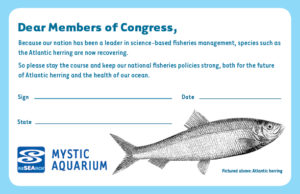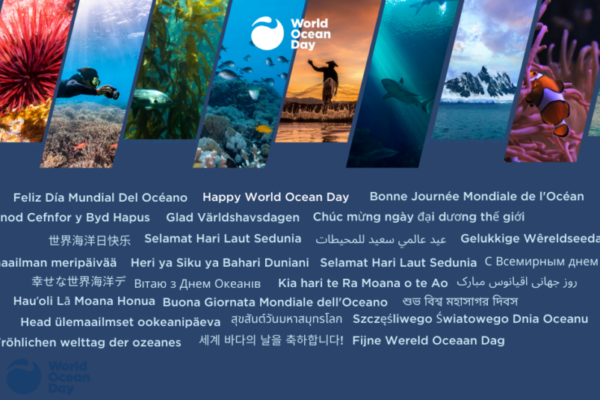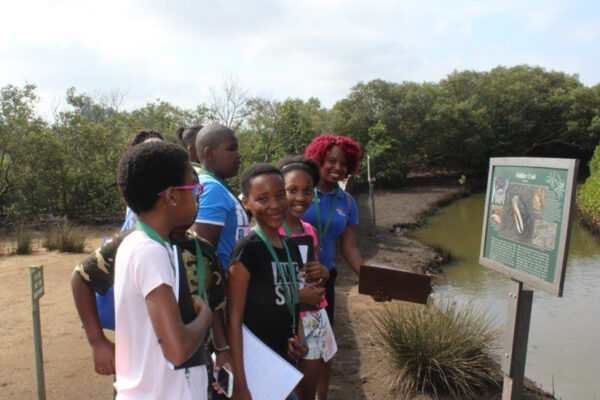While aquarium and zoo leaders from across AZA and ACP are working with The Ocean Project in reaching out to their representatives and senators in support of maintaining a strong and science-based national fisheries policy, we’ve also received some inquiries as to how institutions might operationalize the findings from the recent pilot projects to successfully engage the visiting public.
So with that in mind, here is a quick “tackle box” if you will, the fisheries version of a “toolkit” with what you and your institution can do now to draw public attention and document public opinion on this important ocean issue.
STEP ONE: Identify an already existing opportunity to speak directly with a large groups of visitors, where they can hear directly from staff in a clear and concise way about what is going on, and how they can help. Yes, we had the best overall success when staff at Mystic Aquarium introduced and screened their video PSA at the start of their sea lion show, but we also know it is not realistic for others to develop their own video on such short notice, let alone how many institutions don’t have an appropriate place to show it. With that in mind, think about a dive show, animal presentation or keeper talk.
STEP TWO: Stick to the script! As the interpreters at the Seattle Aquarium were able to show, these same points from the story framework developed by the pilot sites could be easily and effectively incorporated into an existing staff presentation. Here are the essential elements, with a reminder that less can be more! By sticking to the script, each of the pilots successfully covered these points in less than 90 seconds, and still achieved those impressive results. As an example, here is the video PSA, as well as the script, developed by the Mystic Aquarium.
(Optional: Flag the ask)
- Optional opener: Consider telling visitors what to expect, especially if providing a comment card
- Preamble: e.g.,“Today we’re asking our visitors for their thoughts on an important ocean issue…”
Begin with the news of a local species that is recovering, ideally one that visitors already know
- Select a fish: At Mystic Aquarium, they chose the story of the Atlantic herring, while Seattle Aquarium chose the canary rockfish, and Texas State Aquarium chose the red snapper. If you’re looking for another option near you, consult fishwatch.gov to for more information about the status of that fish.
- Begin your script: e.g., “Only a few years ago, we here at (INSERT YOUR AQUARIUM) were quite concerned about the future of (INSERT LOCAL FISH EXAMPLE), but recently we’ve seen their numbers recovering…”
Add the carryover benefits brought by that recovery to the surrounding ecosystem and/or local economy
- Identify the additional benefit(s): How does this fish fit in the local ecosystem, or how is it important to the local economy?
- Add your example: e.g.,This isn’t just good news for the (INSERT LOCAL FISH EXAMPLE), but also for (INSERT LOCAL CARRYOVER EXAMPLE OF ECOSYSTEM AND ECONOMIC BENEFITS)…”
Connect this success back to national policy, while giving the visitor a supporting role by citing sustainable seafood choice
- Make the link: e.g., “This turnaround has been made possible by people like you, who have been increasingly willing to make sustainable seafood choices, and also because we as a country have been doing a much better job managing our fisheries in a way that is science-based”
Relay the urgency, and ask if visitors will join in a show of support together with the aquarium or zoo
- (Re)state the action step: e.g., “Congress is getting ready to review how we manage our national fisheries. Here at (INSERT YOUR AQUARIUM), our message is “stay with science” (or “science is good for the fish and good for fishing”) as while (INSERT LOCAL FISH EXAMPLE) is doing better, we’ve still got a long way to go to ensure that all of our seafood is sustainable seafood. We’re hoping you might join us in relaying that message… ”
 STEP THREE: Provide visitors with an easy action step that they can take then and there! The pilot sites did this by providing custom comment cards that could be signed, adding that those cards from the pilot sites already have been sent on to Congress. You may not see a 62% completion rate as they did at the Texas State Aquarium but know that a good showing often suffices. We know that the timing may seem tight for an aquarium or zoo to print and post these cards, but if you look at the template and sample (right), and I’ll use Mystic’s again just to stick with one, these can be basic and still work well especially if signing is made easy. (Remember the tip to post them on a wall rather than requiring them to be picked up from a table!) Even if the physical cards are presented back to Congress, that documentation of public support can be quite powerful. e.g. “In just three days of showing a 90 second video about the fisheries issue, our aquarium collected more than xx comment cards asking you, Congress, to keep our policies science-based and strong!”
STEP THREE: Provide visitors with an easy action step that they can take then and there! The pilot sites did this by providing custom comment cards that could be signed, adding that those cards from the pilot sites already have been sent on to Congress. You may not see a 62% completion rate as they did at the Texas State Aquarium but know that a good showing often suffices. We know that the timing may seem tight for an aquarium or zoo to print and post these cards, but if you look at the template and sample (right), and I’ll use Mystic’s again just to stick with one, these can be basic and still work well especially if signing is made easy. (Remember the tip to post them on a wall rather than requiring them to be picked up from a table!) Even if the physical cards are presented back to Congress, that documentation of public support can be quite powerful. e.g. “In just three days of showing a 90 second video about the fisheries issue, our aquarium collected more than xx comment cards asking you, Congress, to keep our policies science-based and strong!”
Good luck!




